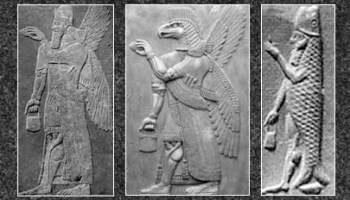We continue considering a paper written by Estonia’s University of Tartu’s Amar Annus, “On the Origin of Watchers: A Comparative Study of the Antediluvian Wisdom in Mesopotamian and Jewish Traditions,” Journal for the study of the Pseudepigrapha, Vol 19.4 (2010 AD): 277-320 (find my series here).

As we shall see, the apkallu are sometimes referred to as sages and sometimes as witches. Here are some descriptions:
…the apkallus had strong ties to Mesopotamian demonology, and they were occasionally counted as evil beings, capable of witchcraft…The apkallus themselves were sometimes viewed negatively as malicious creatures within the Mesopotamian tradition itself…apkallus are occasionally depicted as malevolent beings in Mesopotamian literature…practiced witchcraft…wicked acts…The apkallus occur at least twice in the anti-witchcraft series Maqlu as witches [such as in Maqlû III 61-76].
As a side note: the Maqlu notes that “knots are untied to undo and…counteract the witchcraft.” Knots continue to be used in witchcraft and played a role in the West Memphis Three (WM3) murder case related to Damien Echols, et al. see here.
Conversely to the manner in which they are depicted in an evil light, “The apkallus figure prominently in Mesopotamian ritual and magical texts as protective spirits…In magic [they, as sages] perform purifying and exorcising functions.” Now, “In the Babylonian Creation Epic, some of these beings are counted among evil creations of Tiamat, who are combated by Marduk” and sometimes, “monsters become positive after they are defeated in battle.”
This styled moral relativism or exchange of functions was commented upon by Anthony Green in his “Beneficent Spirits and Malevolent Demons: The Iconography of Good and Evil in Ancient Assyria and Babylonia,” Visible Religion: Annual for Religious Iconography, 1984, 3: 80-105 wherein he notes:
…we should guard against a rigid division, in considering Mesopotamian spirits, between the good and the evil: at times, perhaps, the beneficence or malevolence of individual spirits depended more upon their works at any given time than upon their essential natures. The Seven Gods might at one time be perceived as on the side of good, at another as deadly evil.
Noting such beings being conceived of as moving from a faithful to a fallen state, Amar Annus notes a few texts.
The Dead Sea Scroll 4Q530 Book of Giants (about which I wrote as Dead Sea Scrolls Book of Giants, the Bible & the Book of Enoch) contains a parable, mirrored from Ezekiel 31, with the Watchers as “‘gardeners’ (gnnyn) at work, nurturing and protecting the trees (2 ii 7).”
The apocryphal Book of Jubilees 4:15 and 5:6 notes that God originally sent Angels to earth, “in order to instruct human beings and to act (with) justice and righteousness upon earth.”
There are “ritual texts of ancient Mesopotamia” of which one is plays the main role in Frans Wiggermann’s, Mesopotamian Protective Spirits: The Ritual Texts, Text I of which is an Akkadian text according to which Sebettu, Lugalgirra, “armed ones,” Meslamtaea and Narudda “are strongly associated with netherworld, and therefore they are of half-demonic nature, capable of both good and evil.”
~~~~~~~~~~~~~~~~~~~~~~~~
A plea: I have to pay for server usage and have made all content on this website free and always will. I support my family on one income and do research, writing, videos, etc. as a hobby. If you can even spare $1.00 as a donation, please do so: it may not seem like much but if each person reading this would do so, even every now and then, it would add up and really, really help. Here is my donate/paypal page.
Due to robo-spaming, I had to close the comment sections. However, you can comment on my Facebook page and/or on my Google+ page.
Twitter: #AmarAnnus, #Watchers, #Nephilim
Facebook: #AmarAnnus, #Watchers, #Nephilim
